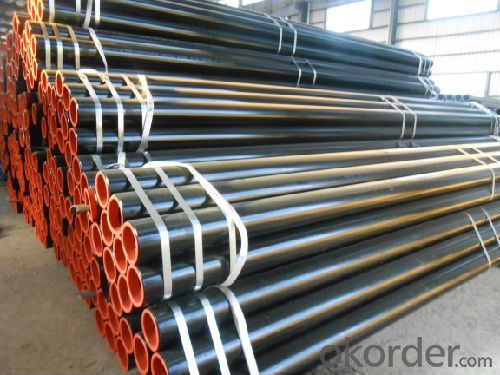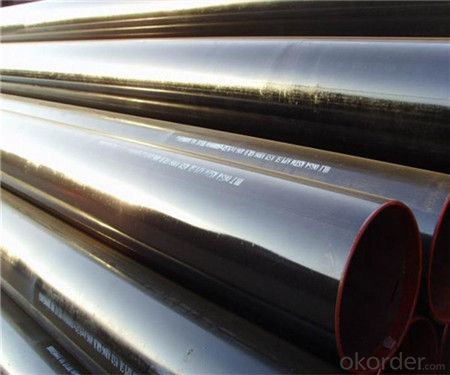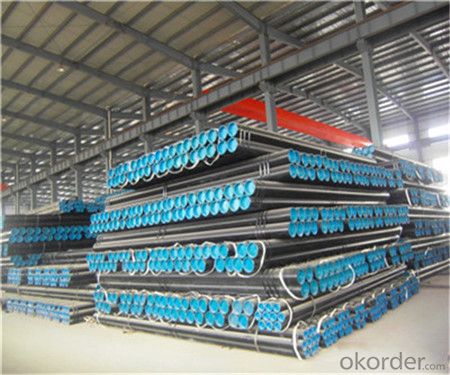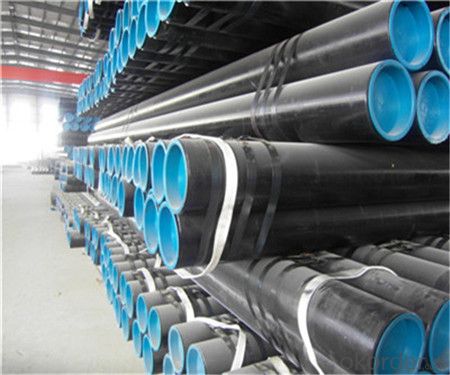Seamless Steel Pipe Line Pipe ASTM A106, ASTM A53, China Manufacturer
- Loading Port:
- China Main Port
- Payment Terms:
- TT or LC
- Min Order Qty:
- 30 m.t.
- Supply Capability:
- 12000 m.t./month
OKorder Service Pledge
OKorder Financial Service
You Might Also Like
1、Full series of products provides an easier access for one stop purchase
▲ Line pipe
▲ Tubing and casing
▲ L & M & H boiler tube
▲ Gas cylinder tube & pipe
▲ Mechanical & Structural pipe
▲ Ship-building tube & pipe
▲ Automobile tube & pipe
2、Main Features of the Seamless Pipe ASTM A106/53:
• High manufacturing accuracy
• High strength
• Small inertia resistance
• Strong heat dissipation ability
• Good visual effect
• Reasonable price
1.Seamless pipe professor
2.MTC,ISO,API certificate
3.ASTM,DIN,BS,JIS,GB
4.On time delivery
5.Big store,excellent package
3、Seamless Pipe ASTM A106/53 Specification:
Standard | GB, DIN, ASTM ASTM A106-2006, ASTM A53-2007 |
Grade | 10#-45#, 16Mn 10#, 20#, 45#, 16Mn |
Thickness | 8 - 33 mm |
Section Shape | Round |
Outer Diameter | 133 - 219 mm |
Place of Origin | Shandong, China (Mainland) |
Secondary Or Not | Non-secondary |
Application | Hydraulic Pipe |
Technique | Cold Drawn |
Certification | API |
Surface Treatment | factory state or painted black |
Special Pipe | API Pipe |
Alloy Or Not | Non-alloy |
Length | 5-12M |
Outer Diameter | 21.3-610mm |
Grade | 20#, 45#, Q345, API J55, API K55, API L80, API N80, API P110, A53B |
Standard | ASME, ASTM |
4、Packaging & Delivery
Packaging Details: | seaworthy package,bundles wrapped with strong steel strip |
Delivery Detail: | 15-30days after received 30%TT |
5、FAQ of Seamless Pipe ASTM A106/53:
①How is the quality of your products?
Our products are manufactured strictly according to national and internaional standard, and we take a test
on every pipe before delivered out. If you want see our quality certifications and all kinds of testing report, please just ask us for it.
Guaranteed: If products’ quality don’t accord to discription as we give or the promise before you place order, we promise 100% refund.
②How about price?
Yes, we are factory and be able to give you lowest price below market one, and we have a policy that “ for saving time and absolutely honest business attitude, we quote as lowest as possible for any customer, and discount can be given according to quantity”,if you like bargain and factory price is not low enough as you think, just don’t waste your time.Please trust the quotation we would give you, it is professional one.
③Why should you chose us?
● Full series of products provides an easier access for one stop purchase
▲ Electric Resistance Welded (ERW) Steel Pipe
▲ Longitudinal Submerged Arc Welded (LSAW) Steel Pipe
▲ Spiral Submerged Arc Welded (SSAW) Steel Pipe
▲ Hollow Section (Square and Rectangle Pipe)
▲ Hot Dipped Galvanized Steel Pipe
▲ Professional sales team
▲ Professional engineering and technology team
▲ Professional exportation and contract processing/management team
▲ Professional cooperators and partners
6、Seamless Pipe ASTM A106/53 Images:




- Q:Under what circumstances can the stainless steel pipe be welded by argon arc, and under what conditions can the arc welding be used?
- Arc welding is the most widely used welding method in industrial production, it is to use the principle of arc discharge (commonly known as arc combustion) the heat generated by the electrode and the work piece and the formation of weld in melting each other after condensation, so as to obtain the solid joint welding process. The scope of application of electric arc welding is very extensive, such as bucket teeth of excavator, loader, bulldozer blade blade plate, screw conveyor, crusher, mixer blade, rail, forging, gear wheel flange, all kinds of mold, slag crusher, ball mill, machine tool equipment etc..
- Q:Can stainless steel pipes be insulated with polybutylene?
- Polybutylene, a plastic material frequently utilized for water supply pipes, is not viable for insulating stainless steel pipes. These pipes, already remarkably corrosion-resistant, do not necessitate additional insulation for thermal purposes. In the event that insulation becomes essential for stainless steel pipes, alternative materials like fiberglass or foam pipe insulation may be employed.
- Q:What is the average cost of stainless steel pipes?
- The cost of stainless steel pipes can differ based on several factors, including pipe size, grade, thickness, supplier, and location. Generally, stainless steel pipes may cost anywhere between $5 and $50 per foot. Nevertheless, it is crucial to acknowledge that prices may vary due to market conditions and other influences. To obtain a more precise estimate for the required stainless steel pipes' specific type and quantity, it is advisable to conduct thorough research and compare prices from various suppliers.
- Q:How do you prevent corrosion in stainless steel pipes?
- To prevent corrosion in stainless steel pipes, there are a few measures that can be taken. Firstly, it is important to ensure that the stainless steel pipes are made from a high-quality grade of stainless steel. Different grades of stainless steel have varying levels of resistance to corrosion, so selecting the appropriate grade for the specific application is crucial. Secondly, regular cleaning and maintenance of the stainless steel pipes is essential. This involves removing any dirt, debris, or contaminants that can potentially cause corrosion. Cleaning can be done using mild soap or detergent, followed by rinsing with clean water and drying the pipes thoroughly. Moreover, it is advisable to avoid using abrasive cleaners or scrubbers that can scratch the surface of the stainless steel pipes, as this can create small crevices where corrosion can occur. Instead, soft cloth or sponge should be used for cleaning. Additionally, it is essential to protect stainless steel pipes from exposure to corrosive substances or environments. This can be achieved by applying a protective coating or using a corrosion-resistant paint on the pipes. This barrier will prevent direct contact between the stainless steel and corrosive substances, reducing the risk of corrosion. Furthermore, maintaining proper water chemistry is important for preventing corrosion in stainless steel pipes used for plumbing applications. Monitoring and controlling the pH level, hardness, and alkalinity of the water can help minimize the corrosive effects on the pipes. Lastly, ensuring proper installation and design of stainless steel pipes is crucial. This includes avoiding tight bends or sharp corners, which can trap moisture and lead to corrosion. Proper insulation and ventilation should also be considered to prevent condensation and subsequent corrosion. By following these preventive measures, corrosion in stainless steel pipes can be significantly reduced, ensuring their longevity and optimal performance.
- Q:Can stainless steel pipes withstand high temperatures?
- Yes, stainless steel pipes are known for their excellent heat resistance and can withstand high temperatures. The specific temperature range that stainless steel pipes can withstand depends on the grade of stainless steel used. Generally, stainless steel pipes can handle temperatures up to 1200°C (2192°F) without losing their structural integrity. In addition to their high-temperature resistance, stainless steel pipes also exhibit good corrosion resistance, making them suitable for various industrial applications where high temperatures and corrosive environments are present, such as in chemical processing plants, power generation facilities, and automotive exhaust systems.
- Q:Can stainless steel pipes be used for oil refineries?
- Yes, stainless steel pipes can be used for oil refineries. Stainless steel is a highly durable and corrosion-resistant material, making it suitable for handling various chemicals and high-temperature environments found in oil refineries. Additionally, stainless steel's strength and reliability make it a preferred choice for transporting and processing petroleum products.
- Q:What is the maximum pressure rating for stainless steel pipe fittings?
- The maximum pressure rating for stainless steel pipe fittings varies depending on several factors such as the material grade, size, and temperature. Generally, stainless steel pipe fittings can handle high-pressure applications due to their inherent strength and corrosion resistance. The pressure rating of these fittings can range from 150 psi (pounds per square inch) to as high as 10,000 psi, depending on the specific fitting and its intended use. It is essential to consult the manufacturer's documentation or industry standards such as ASME B16.11 or ASME B16.9 to determine the maximum pressure rating for a specific stainless steel pipe fitting. Additionally, it is crucial to consider other factors such as the type of sealing method used, compatibility with the fluid being conveyed, and any additional safety measures required in high-pressure systems.
- Q:Are stainless steel pipes suitable for marine applications?
- Yes, stainless steel pipes are suitable for marine applications. Stainless steel is highly resistant to corrosion and can withstand the harsh conditions of saltwater, making it a popular choice for marine applications such as shipbuilding, offshore structures, and marine equipment. It provides excellent durability, strength, and long-term performance in marine environments.
- Q:What factory uses industrial stainless steel tube to be more?
- The automotive industry also has a lot of demand for stainless steel pipes. The main use of stainless steel is the exhaust system, which accounts for more than 1/2 of the total amount of stainless steel in the automobile, and 80% of the ferritic stainless steel. The exhaust gas from the automobile engine flows through the exhaust manifold, front pipe, hose, converter, and central pipe and finally flows out of the muffler. Commonly used in the exhaust system are 409L, 436L and so on. Automobile muffler mainly uses stainless steel pipe. According to estimates, the use of stainless steel pipes in the car accounted for the entire downstream of the stainless steel pipe about 1.5% of the amount, while the use of stainless steel seamless tubes and welded pipe ratio of about 2:1.
- Q:How do stainless steel pipes compare to PVC-U pipes?
- Various piping applications commonly utilize stainless steel pipes and PVC-U pipes, each possessing distinct characteristics and advantages. Primarily, stainless steel pipes are renowned for their remarkable strength and durability. With high resistance to corrosion, rust, and chemical reactions, they excel in applications where contact with aggressive substances or exposure to harsh environments is prevalent. Additionally, they can endure elevated temperatures and pressures, making them well-suited for demanding industrial uses. Conversely, PVC-U pipes, also known as polyvinyl chloride unplasticized pipes, offer lightweight properties and effortless installation. They provide cost-effective solutions and exhibit commendable chemical resistance, particularly against acids, alkalis, and salts. Plumbing, irrigation, and drainage systems commonly employ PVC-U pipes due to their superior flow characteristics and minimal maintenance requirements. Regarding versatility, stainless steel pipes cater to a broad spectrum of applications, including water supply, gas distribution, oil and gas pipelines, and sewage systems. They are frequently favored in industrial environments where reliability and longevity are paramount. Alternatively, PVC-U pipes find more widespread use in residential and commercial settings, prioritizing cost-efficiency and ease of installation. Notably, stainless steel pipes typically entail greater expense than PVC-U pipes, encompassing material costs and installation fees. Nonetheless, their extended lifespan and enhanced resistance to corrosion and chemical reactions often render them a more cost-effective option in the long term. Ultimately, the selection between stainless steel pipes and PVC-U pipes hinges on the specific requirements of the given application. Factors such as cost, durability, corrosion resistance, installation ease, and maintenance should all be contemplated when comparing these materials for a particular piping project.
1. Manufacturer Overview |
|
|---|---|
| Location | |
| Year Established | |
| Annual Output Value | |
| Main Markets | |
| Company Certifications | |
2. Manufacturer Certificates |
|
|---|---|
| a) Certification Name | |
| Range | |
| Reference | |
| Validity Period | |
3. Manufacturer Capability |
|
|---|---|
| a)Trade Capacity | |
| Nearest Port | |
| Export Percentage | |
| No.of Employees in Trade Department | |
| Language Spoken: | |
| b)Factory Information | |
| Factory Size: | |
| No. of Production Lines | |
| Contract Manufacturing | |
| Product Price Range | |
Send your message to us
Seamless Steel Pipe Line Pipe ASTM A106, ASTM A53, China Manufacturer
- Loading Port:
- China Main Port
- Payment Terms:
- TT or LC
- Min Order Qty:
- 30 m.t.
- Supply Capability:
- 12000 m.t./month
OKorder Service Pledge
OKorder Financial Service
Similar products
New products
Hot products




























